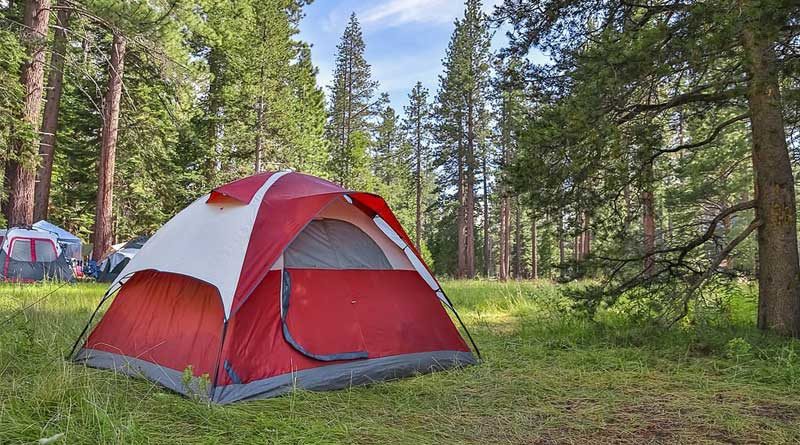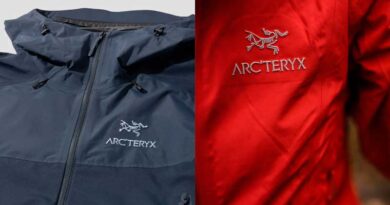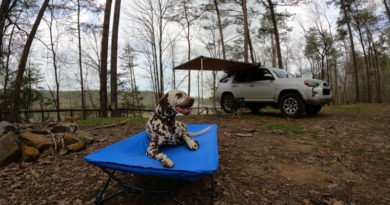Can You Use A 4-Season Tent In Summer?
A 4-season tent implies that the tent can be used all year round. It is a tempting proposition. Tents aren’t cheap so instead of getting more than one tent, you can spend a huge sum once that will keep you comfortable for the rest of the year. Or maybe you usually camp in the chilling winter but have decided to camp in the summer this year. A 4-season tent can be used in summer but that depends on where that summer is going to be. Summer in high mountains is different from summer in a tropical forest or a desert. But in really hot weather, you shouldn’t use a winter tent. Get a cheap summer tent or invest in a proper 3-season tent. If you camp in the summer rarely, then you can also rent a tent.
For more details on what problems you can have with a 4-season tent in the summer and why it isn’t recommended, keep reading.
What is a 4-Season Tent?
4-season tents are tents that are primarily meant for winter because they can keep you warm during cold weather involving snow and cold showers. Of course, such tents can easily be used for the rest of the year as well.
The target market for a 4-season tent is those that are involved in a range of activities in almost all types of weather conditions throughout the year. They are worth their value for those looking to invest in a single tent. Buying two tents, a 3-season and an expedition tent would cost you a lot.
Besides, expedition tents are overkill for most people anyway. They are for extreme conditions that a normal winter camper rarely faces. A 4-season tent is a mixture; a toned-down version of an expedition tent and an upgraded version of a 3-season tent.
A 4-season tent won’t be able to handle a blizzard or a few feet of snow, but the nylon walls would keep you safe from cold winds. These walls would also protect you from blowing sand when camping in a desert or on a beach. If you do a lot of summer camping, a 4-season tent would feel cramped and sweaty. If winter camping is only a once-a-year affair for you, then you are better off borrowing or renting a 4-season tent.
Black Diamond Eldorado: A 4-Season Option
Weight: 5 lbs. 1 oz.
Capacity: 2 persons
Floor Area: 30.8 sq. ft.
Peak Height: 43 in.
Black Diamond Eldorado is a classic example of a 4-season tent. Even though this tent has been updated over the years, the shape hasn’t changed much. The build quality and durability are excellent, and the Eldorado has proven itself over the years. It has been used for expeditions on Mount Everest and has been a popular choice for alpine summits.
The best feature about Eldorado is that it is extremely durable, yet, it is also lightweight somehow. The lightweight of this tent allows you to use it for alpine summits as well. The poles of the Eldorado are on the inside of the tent which is odd for a 4-season tent as they have external poles for better support. The MSR Advance Pro 2 is one such example having a similar shape and specs as the Eldorado but costing less.
But the Eldorado is a single-person tent with only enough space for gear. Two persons are a tight squeeze in the tent. The Eldorado also lacks a vestibule which limits the performance of the tent. The tent also has a single wall design. A similarly priced MSR Access 2 is lighter weighing only 4lb. 1oz. compared to the 5lb. 1oz. of the Eldorado with a double-wall design, two vestibules, and available as a 3-person tent.
What I like: Great durability, compact footprint, a good balance of weight and strength
What I don’t: Limited ventilation, difficult to set up, insufficient guy lines included
See the Black Diamond Eldorado
Problems with a 4-Season Tent in Summer
As with every jack-of-all-trades, there are compromises.
- The major issue you are going to have is carrying a heavy load on your back. 4-season tents weigh easily around 6 – 6.5lbs, around double compared to an average backpacking tent. A 2-person backpacking tent weighs around 3 – 3.5lbs.
- Of course, your other stuff is going to add to this weight. Your overall backpack would be a problem for you to carry in the heat of summer, especially, if you would be walking miles to reach your campsite. Premium tents that have a double-wall design do allow removing the outermost wall for summer use. But stronger poles and heavier fabric still make them heavy.
- Another major issue of 4-season tents is poor ventilation. 4-season tents lock in heat during cold nights which they also do during the summer evenings. It should be obvious that you won’t find a tent that works in the desert heat and winter mountaineering.
- A 4-season tent is not designed to let air through. Although 4-season tents have windows and vents, they can’t compete with the mesh walls of a 3-season tent. In the summer, you would have to make some effort to keep your tent cool. But, then again, it depends on what you mean by summer. Summer in the mountains is different from summer in the desert.
- Of course, poor ventilation also means you have to deal with condensation. Condensation becomes an annoying problem during summer. There is no way to completely eliminate condensation. You can only slow it down so that your stuff doesn’t get wet. But the best way to do that is good airflow, opposite of what 4-season tents are designed for.
3-Season vs. 4-Season Tent
The differences between a 3-season and a 4-season tent may not be obvious to casual observation but when you observe carefully, these differences begin to stand out. For example, 4-season tents are made of stiffer material. The poles create an A shape that prevents snow buildup on top of the tent. The frame shape also prevents sagging, flapping, and bending in the wind.
3-season tents, on the other hand, have bows and bends in their poles to give a more box-like shape that optimizes the ratio of the interior space to weight. 4-season tents also have nylon fabric instead of mesh to seal warmth and prevent drafts and snow from getting inside the tent. They also have more guy-out points, higher-denier materials, and more vents than 3-season tents.
REI Co-op Half Dome SL: A 3-Season Option
Weight: 4 lbs. 11.5 oz.
Capacity: 2 persons
Floor Area: 33.75 sq. ft.
Peak Height: 42 in.
REI is known for its great products at a very reasonable price. The REI Co-op Half Dome SL 2+ is no exception. At a significant price difference from premium 3-season tents, like the Big Agnes Copper Spur HV UL2, the Half Dome provides almost the same kind of performance.
Due to its popularity, the Half Dome has gone through multiple iterations. The latest iteration came in 2021 which reduced the weight of the tent by using a lighter fabric. But while the weight of the fabric has been reduced, it has still been kept durable with a 40D rating.
This tent is extremely roomy inside. In fact, its interior space is a standout point compared to the competition. You get a large 35.8-square-foot of floor space that can accommodate two backpacking pads and still have space to spare. The shape of the tent is also symmetrical giving equal space to two people sleeping inside the tent.
The SL in the name stands for “super light”. The complete packed weight of the tent, which includes the footprint as well, measures 5lbs. That means you can still shave off some weight by leaving the footprint behind.
The Half Dome has a durable 40D fabric with a 30D rainfly which can stand up to some rough handling. The quality is top-notch. The external poles make it easier to assemble and take down the tent. Funnily, the 4-season tent in this article comes with internal poles and the 3-season tent comes with external poles. Usually, it is the opposite. But the Half Dome is a great example of a great 3-season tent at a reasonable price.
What I like: Spacious, good price, comes with a footprint
What I don’t: A little heavy for a 2-season tent and bulky pole design
See the REI Co-op Half Dome SL
Final Thoughts
You can use a 4-season tent for camping in summer but the trip won’t be enjoyable unless you are camping in the mountains where even summer is cold enough. But if you are camping somewhere hot, then a 4-season tent isn’t a very good job done. It will get the job done, but it won’t be pleasant. If you camp in summer frequently, then it is better to get a 3-season camp. But if you camp in summer only once or twice a year, then you can make your 4-season tent work. Another option is to get a cheap summer tent which will last 1 – 2 seasons.






